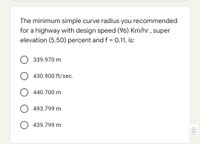
Structural Analysis
6th Edition
ISBN: 9781337630931
Author: KASSIMALI, Aslam.
Publisher: Cengage,
expand_more
expand_more
format_list_bulleted
Concept explainers
Question

Transcribed Image Text:The minimum simple curve radius you recommended
for a highway with design speed (96) Km/hr , super
elevation (5.50) percent and f = 0.11, is:
339.970 m
430.900 ft/sec.
O 440.700 m
O 493.799 m
O 439.799 m
Expert Solution
This question has been solved!
Explore an expertly crafted, step-by-step solution for a thorough understanding of key concepts.
Step by stepSolved in 2 steps

Knowledge Booster
Learn more about
Need a deep-dive on the concept behind this application? Look no further. Learn more about this topic, civil-engineering and related others by exploring similar questions and additional content below.Similar questions
- only do question 4arrow_forwardAn equal-tangent vertical curve is designed for the year 2030 for a design speed of 70 mi/h to connect grades G1 = 1.2% and G2 = - 2.1%. In 2030, vehicles have become smaller so that the driver's eye height is assumed to be 3.0 ft above the pavement and roadway objects are assumed to be 1.0 ft above the pavement surface. Compute the design curve length for the year 2030. A. 1178.02 В. 1032.09 C. 974.12 D. 980.25arrow_forwardAn equal-tangent crest vertical curve is 1100 ft long and connects a +2.5% and a -1.5% grade. If the design speed of the roadway is 85 mi/h, determine the length of curve, does this curve have adequate passing sight distance?arrow_forward
- Please answer question below and include all steps on how you got the answerarrow_forwardAn equal-tangent vertical curve connects a +3.2 % and a -1.1 % grade. The PVI is at station 100+20 and elevation 950 ft and the PVT is at station 105+20. Answer the following 5 questions Question 3 to Question 7. The station of the PVC is at: sta 93+20 sta 95+20 sta 97+20 sta 99+20 sta 105+20arrow_forwardQUESTION 3 A vertical curve is needed to join to tangents; G₁-5% and G₂-2%. Assuming the worst case scenario for braking, and the AASHTO recommended values for deceleration and perception-reaction time, calculate the minimum length of curve (ft) needed to satisfy the safety criteria. The design speed is 50 mph.arrow_forward
- A+1 percent grade intersects with a-2 percent grade at station (535+ 24.25) at an elevation of 300 t. (a) if the design speed is 65 mi/h, determine the minimum length (in t) of vertical curve using the rate of vertical curvature. (Assume the stopping sight distance is less than the length of the curve.) it (b) Using the length found in part (a), find the stations and elevations (in R) of the BVC and EVC and the elevation (in t) of each 100 t station. (In the table below, the first row corresponds to the BVC and the last row corresponds to the EVC. Round your elevations to at least one decimal place.) Station Elevation (t) 533 + 00 534 + 00 535 + 00 536 + 00 537 + 00 538 + 00 (c) Using the length found in part (a), find the station and elevation (in t) of the highpoint. station nlevationarrow_forwardA vertical curve is needed to join to tangents; G1=1% and G2=4%. Assuming a level grade (0%) for braking, and the AASHTO recommended values for deceleration and perception-reaction time, calculate the minimum length of curve (ft) needed to satisfy the safety criteria. The design speed is 60 mph.arrow_forwardA vertical curve is required to join a road with + 2.5% grade to a road with -3% grade. The design speed of the road is 90 kmph and safe stopping sight distance is 180 m on the road. The coordinates of VPI is (500 m, 100 m), with respect to a fixed bench mark. The horizontal co-ordinate of highest point of curve with respect to fixed benchmark is m. (rounded off to two decimal place)arrow_forward
- A circular curve of the highway is designed for traffic moving at 50 mi/hr. If the radius of the curve is 550 ft, what is the correct angle of banking of the road?arrow_forwardA vertical curve is needed to join to tangents; G₁=2% and G2-5%. Assuming the worst case scenario for braking, and the AASHTO recommended values for deceleration and perception-reaction time, calculate the minimum length of curve (ft) needed to satisfy the comfort criteria. The design speed is 50 mph. Response Feedback: G2-G₁ is positive, therefore a sag curve. A=3 Lmin-AV²146.5arrow_forward
arrow_back_ios
arrow_forward_ios
Recommended textbooks for you

 Structural Analysis (10th Edition)Civil EngineeringISBN:9780134610672Author:Russell C. HibbelerPublisher:PEARSON
Structural Analysis (10th Edition)Civil EngineeringISBN:9780134610672Author:Russell C. HibbelerPublisher:PEARSON Principles of Foundation Engineering (MindTap Cou...Civil EngineeringISBN:9781337705028Author:Braja M. Das, Nagaratnam SivakuganPublisher:Cengage Learning
Principles of Foundation Engineering (MindTap Cou...Civil EngineeringISBN:9781337705028Author:Braja M. Das, Nagaratnam SivakuganPublisher:Cengage Learning Fundamentals of Structural AnalysisCivil EngineeringISBN:9780073398006Author:Kenneth M. Leet Emeritus, Chia-Ming Uang, Joel LanningPublisher:McGraw-Hill Education
Fundamentals of Structural AnalysisCivil EngineeringISBN:9780073398006Author:Kenneth M. Leet Emeritus, Chia-Ming Uang, Joel LanningPublisher:McGraw-Hill Education
 Traffic and Highway EngineeringCivil EngineeringISBN:9781305156241Author:Garber, Nicholas J.Publisher:Cengage Learning
Traffic and Highway EngineeringCivil EngineeringISBN:9781305156241Author:Garber, Nicholas J.Publisher:Cengage Learning


Structural Analysis (10th Edition)
Civil Engineering
ISBN:9780134610672
Author:Russell C. Hibbeler
Publisher:PEARSON

Principles of Foundation Engineering (MindTap Cou...
Civil Engineering
ISBN:9781337705028
Author:Braja M. Das, Nagaratnam Sivakugan
Publisher:Cengage Learning

Fundamentals of Structural Analysis
Civil Engineering
ISBN:9780073398006
Author:Kenneth M. Leet Emeritus, Chia-Ming Uang, Joel Lanning
Publisher:McGraw-Hill Education


Traffic and Highway Engineering
Civil Engineering
ISBN:9781305156241
Author:Garber, Nicholas J.
Publisher:Cengage Learning